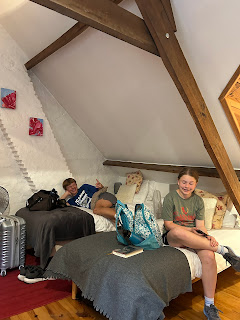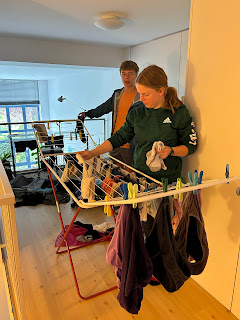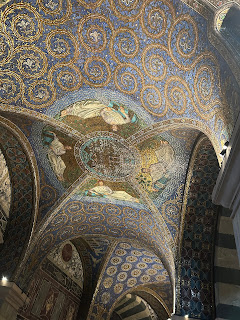The drive to Bruges was pretty uneventful, but our rental car was driving us nuts! The car beeped anytime we went 2 km/hr over the posted speed limit (it knew!), if we switched lanes without signaling it would fight against us, and it would beep at us if it thought we needed to "focus on driving!" We searched all the menus and sought help online, but we did not have the right access to turn off that nonsense. Anyway, we arrived without tearing the car apart. Our B&B was in old Bruges, so we got to go through one of the original 14th century city gates, called Smedenpoort, just wide enough for a car.
Then we managed to find street parking to drop off bags and make our way up to our room on the 4th floor (more tiny steep stairs!), in an attic space. The hostess left us directions on where to leave our car for free parking (at a park just outside the gate), which turned out to be fine and actually free! The room was cute, with two sleeping areas and a decent bathroom, with the door at the foot of the last set of stairs. There wasn't any A/C, but the windows pivoted in the center, as depicted in the first picture, and we opened them all and turned on the fans to air out the space and get a mild cross breeze. Hadley stuck her head out of the bathroom window, while I stood on our bed for the 3rd picture.
All right, now to see about dinner. We tried a highly rated burger joint a few blocks away, but they didn't taste quite right, not that we had very high expectations. Oh well, time to explore Bruges a bit before bedtime. Turns out it was the last weekend of a pilgrimage, which apparently meant they had a carnival stuffed into the old town between us and the central square. Talk about a very strange juxtaposition with cheesy carny rides next to medieval homes and cobblestone streets. I was a bit disappointed, because that's not what we were expecting or wanting out of our Bruges experience. Luckily, we made it past the chaos and crowds to the Market Square for sunset. A large open area surrounded by shops, museums, restaurants, and the 13th-century belfort, this is the heart of Bruges. We stayed until the lights came on, and then headed back to our beds in the attic.
If we tried to ignore the tour groups, we could appreciate the scenery and imagine a quainter way of life. Bruges is filled with canals, and the ducks and swans had to compete with tour boats for water space. It was still duckling season, so we saw lots of little birds following their parents. On land, the horse-drawn carriages added to the charm, with very few cars on the roads in the inner city.
Finally, we found the Halve Maan brewery, the original Bruges craft brewery, though fairly young for the city at just 170 years old. We enjoyed a sampling of the beers, while the kids ordered more Belgian waffles.
The next morning after our B&B breakfast, we hit the road again to close the loop back to Amsterdam. We passed through a lot of rain around Antwerp, but it cleared up soon after. We made a stop at Kinderdijk, a world heritage site. Think classic 18th-century Dutch windmills, now add bikes. It doesn't get much more Dutch than that! We ate our leftover "sandwiches" from breakfast at a picnic table and rented bikes for a couple of hours, since we enjoyed our Alaskan biking so much. There is a whole network of trails over flat terrain, next to canals full of waterlilies and ducks, and the weather was perfect!
From there, it was a short drive back to Amsterdam, where our final two nights would be in a houseboat. We're going for all the stereotypes here. It was in a great location, not far from where we boarded our canal cruise a week prior, with two bedrooms, one of which was on the roof and had a good view of North Amsterdam. I wish I'd gotten a picture at night when it was all lit up!
After lunch, we had to cross the city through its narrow lanes (left) to make our Anne Frank ticket time. This museum is set up in the secret annex (and adjacent buildings) where 8 people, including Anne Frank, hid for 2 years during WWII. They didn't allow pictures inside, so this was the best I could do (right). It was a very moving experience, literally and figuratively. It was a bit like the Vatican where you just had to keep moving in a long continuous line...



























































































